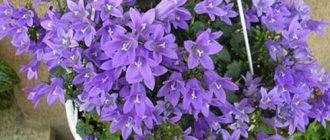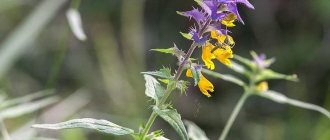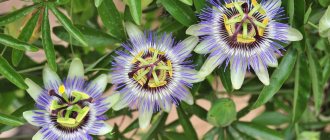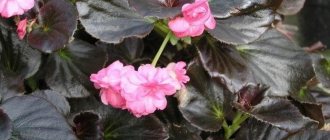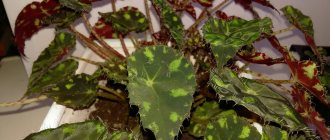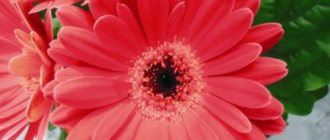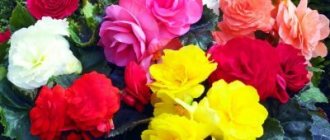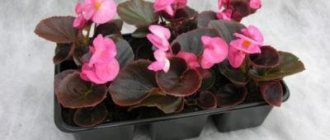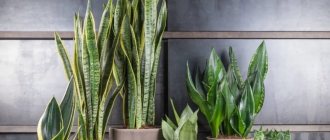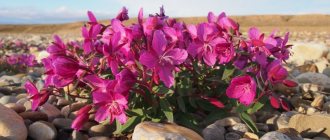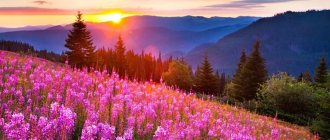Flower Ivan da Marya indoor begonia what it looks like
Begonia Ivan da Marya grows as a bush, with beautiful green leaves and red flowers. On one plant there are two types of flowers, which always appear in pairs - double ones similar to a rose and ordinary ones with four or five petals. With proper care, it blooms almost constantly, so it can decorate any interior.
Planting and care, growing rules
It is known that any variety of begonia prefers light, loose, organically enriched soil compositions. A composition of greenhouse soil, manure, and peat, taken in equal parts, is best suited. A little river sand is added to improve drainage. Begonias need good lighting. For this reason, containers with flowers are placed on windows facing east or west.
During the growing season, the plant is kept at a moderate temperature, from eighteen to twenty degrees Celsius. In winter it is lowered somewhat - to fifteen. The humidity content in the air does not matter. Additional spraying is allowed for varieties with smooth foliage. But there is a peculiarity here - water should not get on the inflorescences.
Watering with soft water is carried out regularly; the soil should not dry out. In summer its intensity is twice a week. During the hot period, the procedure is carried out daily. Make sure that moisture does not stagnate. From mid-autumn, the amount of watering is slightly reduced.
With the onset of spring, the dosage of added moisture gradually increases in order to reach the required level in May. Overmoistening of the soil threatens rotting of the root system and young shoots, and the development of powdery mildew, which can destroy the plant.
Only feed the begonia that grows in the old soil composition. Procedures are carried out weekly from May to October so that the foliage of the plant develops better. For this purpose, special preparations intended for flowering plants are used.
Transplantation and propagation features of begonia
The recommended period for replanting is early spring. It is performed if necessary, when the root system fills the entire flower container. You should not resort to such measures more often - begonia will not please you with its flowering. The fragility of the root system requires great care when replanting the plant. A drainage layer must be placed at the bottom of the pot.
The plant is propagated by stem or leaf cuttings. Tuberous varieties can also reproduce by dividing the nodules. For cuttings in the spring, prepared shoots are placed in the soil and given the opportunity to form roots, periodically moistening the soil. The method is not entirely convenient, since the sprouts often rot or form roots slowly. You can place and add an activated carbon tablet or a rooting accelerator to the water.
For leaf cuttings, the most developed leaves are determined, cut off, placed in a moist substrate (sand - 3, peat - 1 part) and placed in a shaded place.
Protecting plants from diseases and pests
Begonia is affected by downy mildew.
Excess moisture causes the formation of fungal diseases. In order to promptly detect an unpleasant problem, we recommend observing the appearance of the core of the bush and its lower leaves, on which rot or dew most often appears. Affected leaves are immediately removed, and the amount of watering is sharply reduced. These measures will prevent the proliferation of fungal pests. Begonia is most often attacked by aphids and red spider mites. They must be combated by spraying, for which special preparations are used.
Begonia is considered a wonderful plant. With proper care, it perfectly decorates a window, balcony or loggia. Doesn't require any special attention.
Ivan da Marya - flower legend and healer
Ivan da Marya is the name given to several types of plants. Most often it refers to oak grass, which also has other names:
- bicolor,
- Ivanets,
- brother and sister,
- honeydew,
- linden,
- scrofulous grass,
- jaundice,
- Ivanova or marks grass.
Male and female names were popularly given to plants that bloom in multi-colored or differently shaped pairs of inflorescences. These include meadow sage, periwinkle, Geneva violet, tricolor violet, and campanula.
Ivan da Marya
The colorful name of the flower was given for the contrasting combination of the yellow corolla of the flower with a purple bract. This unusual phenomenon is associated with the legend of the tragic love of a young man and a beauty. Ivan is associated with the color yellow, and Marya with purple. The ancestors endowed the flower with magical properties and kept it in the house as a talisman of marital happiness and protection from evil forces.
Ivan da Marya is part of the wreath for fortune telling on Ivan Kupala. The union of yellow and blue is considered a combination of the elements of water and fire. According to legends, the flower helps to establish a union between man and the gods, heavenly and earthly. The flower gives eternal happiness, harmonizing the elements of yin and yang.
The grass collected on Kupala night was tied into brooms and taken to the bathhouse to gain health and well-being.
Treatment of high blood pressure with infusion of Ivan da Marya
An infusion of Ivan da Marya prepared at home is an effective medicine against hypertension. Active elements reduce blood pressure, have a beneficial effect on blood vessels - they strengthen, increase the elasticity of the walls, and normalize blood formation.
In the complex treatment of hypertension, it is recommended to follow simple rules - do not take pharmaceutical drugs or herbal remedies at the same time.
Some substances contained in oak grass can react with medications, cause side effects, and serious health complications. Step-by-step folk recipe:
- Mix dry vegetable raw materials Ivan da Marya (teaspoon) and boiling water (200 ml) in a thermos.
- Infuse the homemade medicine in a thermos for at least an hour.
- Carry out filtration, carefully squeeze the cake through a gauze cloth folded in 2-4 layers.
Divide the prepared herbal medicine into three parts and use throughout the day. The most effective would be to take after a meal - on an empty stomach the product can cause irritation of the mucous membranes.
It is strictly forbidden to exceed the dosage - if the body is hypersensitive, it can cause serious poisoning.
Features of the plant
Small flowers produce abundant nectar that attracts bees, and the fruits serve as food for forest inhabitants.
Interestingly, thanks to the aromatic oils on the seeds, ants love them and actively move them along their paths, where dense thickets grow in the spring. Thus, the flower Ivan da Marya (photo) is spreading to new territories.
Mariannik oak grove is considered a semi-parasite. Its root system forms suckers that attach to the rhizomes of neighboring plants and are fed by their juice. Successfully parasitizes spruce, hazel, willow, alder, lungwort and shepherd's purse. When the feeding plant is weakened, it dies along with it.
The flower is common in forests and forest-steppe. It is found on deciduous forest edges, in groves, among bushes, in wet meadows and on the slopes of ravines. Selects shady places for growth, where it forms dense growth.
Beneficial features
Oak grass is a poisonous plant that requires careful handling. However, it has long been used in herbal medicine as a remedy that has a sedative, wound-healing, anticonvulsant and anti-inflammatory effect.
Ivan da Marya flowers are used for heart diseases and digestive problems, rheumatism, hypertension, neuralgia and epilepsy. Healing baths are prepared for skin diseases such as eczema, scabies, rashes, and diathesis. They drink tea from maryannik for scrofula.
Medicinal raw materials include stems, leaves, flowers and even seed pods. The ground part is harvested during flowering.
Once upon a time, a decoction of marianberry fruits was used to dye fabrics yellow and as an insecticide against insects.
Field mariannik
Practical significance
Humans use the oak grass as a medicinal plant and an object for pharmacological research. The decorative nature of the Ivan da Marya flower gives it aesthetic value, but it is impossible to use it to create bouquets due to its rapid withering.
The oak grass is poisonous, therefore it can cause poisoning of livestock. Cows that eat this plant suffer from spoiled milk taste. If used carelessly for medicinal purposes, the flower becomes dangerous to humans.
In agriculture, oak grass is good as an insecticide. This plant is also of interest as a honey plant.
Home flower Ivan da Marya
The indoor variety of Ivan da Marya is tuberous begonia, which differs significantly from the wild species. Outwardly, it looks like a bush with leaves rounded at the base, elongated in one direction. Outline of a leaf with small teeth. The flower produces two types of buds. Some are double, similar to red rose buds, while others are ordinary, with 5 petals.
Lugovoy
Begonia tubers for planting must be free of damage and signs of rot. They are put up for germination in February. The container is filled with loose substrate with the addition of peat. The tubers are laid out on a damp surface and not sprinkled. Keep in a bright and warm place. Soil is added when the sprouts reach 6-8 cm. Flowering begins in June and lasts until autumn. Watering is moderate, along the edge of the pot. Organic and mineral fertilizers are recommended.
The perennial indoor flower is propagated by seeds and cuttings.
Mariannik oak forest. Field mariannik (Ivan da Marya)
Field weed (lat. Melampyrum arvense) is an annual herbaceous weed that belongs to the root semi-parasites.
The popular nickname “Ivan da Marya” was given to the plant for its elegant, festive decoration.
The distribution area of maryannik is quite wide and covers almost the entire European continent, Crimea, the Kerch Peninsula, the Caucasus and further up to Western Siberia inclusive.
Most often, marianberry can be found in the steppe zone, on the edges of mixed birch and oak forests, among shrubs, and on calcareous soils.
It is considered a malicious weed because special suckers (glaustoria) are formed on its roots, with the help of which it attaches to the root system of other plants and then lives at their expense. As a result, the infected plant is forced to “work” for two, and therefore lacks moisture and nutrients, weakens and dries out prematurely. Of course, the marian plant also begins to experience a deficiency of minerals and water, but by this time, as a rule, it already has time to throw out the seeds.
Previously, farmers considered field grass to be a forage plant. It was well consumed by cattle, but to a much lesser extent by horses, goats and sheep.
Later, scientists found out that ripened marianberry seeds are capable of accumulating a special toxin, rhinanthin (a glucoside substance with an acute local and general narcotic effect), and they stopped using the plant as animal feed.
Marianberry seeds can get into cereal grains as impurities during harvesting. If this happens, the flour produced from contaminated raw materials acquires an unsightly purple color.
At the same time, field grass is an excellent honey plant and blooms throughout the summer, attracting bees with pollen and a large amount of nectar.
It is noteworthy that the spread of this plant is greatly facilitated by forest ants, which are attracted by the fleshy appendage on the seeds of the plant, and they take them all over the area.
Description of the plant
Marjannik has a pubescent, straight and branched stem with upward-facing shoots that reach a height of 15 to 50 centimeters.
Its root is shallow, underdeveloped and equipped with special suction cups, adapted for penetration into the root systems of other plants in order to obtain nutrients and moisture.
The leaves are lush green in color, opposite, sessile, lanceolate or linear. They are pointed and jagged at the base, and their undersides have a slightly rough surface.
The plant blooms from May to September inclusive. The flowers are in dense, spike-shaped, cylindrical inflorescences and face in all directions.
The corolla of maryannik can reach 20 centimeters in length. It is purple or light pinkish in color and covered with small white or bluish bristles.
The calyx reaches 2 centimeters in length. It is pubescent and equipped with five long teeth.
The fruit is a polyspermous, ovoid, flattened capsule containing oblong, smooth and slightly curved dark brown seeds, reaching 5 millimeters in length.
Growing in the garden
When growing Ivan da Marya in a garden plot, for decorative purposes or for medicinal raw materials, they begin by preparing the soil. It should be loose and moist. During the preliminary digging, fertilizing from mullein is applied.
Seeds are planted in the winter in order to get early shoots and May flowering in the spring. It should be taken into account that the maryanka has low seed germination and in the spring the crops will have to be renewed. Large seeds are pressed into the soil or sprinkled with a thin layer of soil. For development and bright flowering, the flower requires a moist environment.
The site is chosen in partial shade so that the sun's rays can brighten the inflorescences. Ivan da Marya does not require feeding. The flower independently obtains nutrients from other plants or synthesizes them.
The cultivation of oak grass in garden plots has not become widespread due to the fact that the plant is a semi-parasite. Sometimes it is planted in gardens in a natural style as a border plant or in compositions with stones and decorative driftwood in combination with small plants.
Watch also the video on the topic:
Useful and healing properties of the flower
Traditional healers use the culture to treat stomach and heart pathologies (be sure to follow strict dosage). Maryannik is used for high blood pressure, epilepsy, and disorders of the gastrointestinal tract. Externally in the form of bath products and other methods, the medicine is used for rashes, diathesis and skin tuberculosis. Fresh grass in crushed form is used for rapid healing of wounds.
Beneficial properties of oakberry maryannik:
- has a calming and antiseptic effect;
- helps in the treatment of veins;
- accelerates wound healing;
- has anti-inflammatory and insecticidal effects.
Aucubin contained in the plant has antibacterial and anti-inflammatory properties. The stems, leaves, flowers and fruits are used for therapeutic purposes.
Healing properties for women
An infusion or tincture is used for stress, depression and other nervous disorders, which is the main cause of female pathologies. The medicinal properties of the herb are aimed at improving the condition of the nervous and cardiovascular systems. In combination with other medicinal mixtures, maryannik is used in the treatment of benign tumors in women.
the flower is used in the treatment and prevention of various pathological conditions
Maryannik, Ivan-da-Marya, yellow grass, scrofulous grass
OAK MARYANNIK (Melampyrum nemorosum L.), or IVAN-DA-MARYA , is an annual herbaceous plant with a pubescent stem, of the family Scrophulariaceae, genus Melapyrum L.. Leaves are opposite, ovate-lanceolate. The flowers are light yellow, two-lipped, collected in spike-shaped inflorescences (the lips are yellow, the corolla tube is red-yellow). The flowers have comb-toothed purple bracts. The fruit is an ovoid capsule. The seeds are large, oblong, brown or almost black, with an apex. Height 15-60 cm.
The plant stands out for its particularly striking contrast of blue bracts and bright yellow corollas. It is very decorative, which is why it often attracted the attention of painters and poets, but when picked into bouquets it quickly fades. The flowers of Ivan da Marya produce nectar abundantly and are rightfully considered a good honey plant. The seeds serve as food for forest game.
Common names: oak grass - Ivan-da-Marya, Ivanets, Ivan's grass, maryannik, brother and sister, pansy, two-flowered, yellow grass, scrofulous grass, fireflower; meadow marianberry - Petrovskaya grass, magpie shavings, field cornflowers, kusharka, lucre, jaundice; forest herb - oppressive grass, mare's grass; field grass - vertebra, bellweed, willow-herb, yellowhead, coltsfoot, field grass.
Many legends associated with Ivan da Marya are dedicated to the symbolism of forbidden love. If you believe the fairy tale, the name Ivan-da-Marya arose like this: fate separated brother and sister - Ivan and Marya - in childhood. When they grew up and met, they fell in love with each other, but having learned about their relationship, in order not to be separated, they turned into a flower with a double color. The harshest version of the legend says that the sister wanted to seduce her brother, and he killed her for this (see “Legends of the Violet”).
Flowers and fruits
The flowers of the oak grass are collected in a group. By location, the inflorescence is apical and is a one-sided raceme, the length of which reaches 17 cm. The flowers sit on very short (up to 1 mm) pedicels and are surrounded by bracts that have a rich blue-violet color. The corollas themselves are bright yellow, which creates a beautiful contrasting effect.
In the photo, Ivana da Marya flowers look like a long patterned purple pole, hung with solar lights. Such a picture very often attracted the attention of painters and poets. When in the photo the Ivan-da-Marya flower blooms not in a single specimen, but in a group, then the area of the clearing, edge or forest canopy captured on camera looks like a variegated green-yellow-violet carpet.
We recommend reading: Useful properties and contraindications of horsetail
The bracts are smaller in size than the leaves (from 1 to 3 cm in length and up to 1.8 cm in width) and are often located on the stem. The edges of their plates are no longer solid, but comb-toothed.
Flowers of Ivana da Marya are zygomorphic, five-membered, with a two-lipped corolla (formula Ch(5)L(5)T(5)P(2)). At the base there is a cup that forms a 5 mm tube, from the top of which 4 long teeth with strongly pointed ends extend.
The flowering period lasts from May to September, and from June the fruits begin to ripen, which are oblong or elliptical-lanceolate boxes. They contain blackish seeds 5-6 mm long, which fall out as a result of bivalve opening.
Mariannik oak grove and its medicinal properties
The plant is poisonous. The internal use of maryaniki, as poisonous plants, requires great caution. It is known that the plant contains traces of alkaloids, the glucoside melompicrite (dulcite), and in the seeds - a very poisonous glucoside rhinantine (aucuban), which has a narcotic and local irritant effect. When poisoned by seeds, weakness, drowsiness is observed, and cardiac activity is weakened.
Poisoning of sheep and horses may occur when they are fed grain and flour contaminated with marianberry seeds. Sick animals become drowsy, tremble, have blood in their urine, and have palpitations. First aid consists of first prescribing laxatives, and then conducting a course of symptomatic therapy (stimulants, cardiac drugs, etc.).
Currently used only in folk medicine. For medicinal purposes, the herb of the plant is used, which is harvested during the flowering period. Air dry in the shade or in well-ventilated areas. The part used is grass (stems, leaves, flowers) and fruits. The grass is harvested in May - September, the fruits - in July - September. Directions for use: Infuse 3 tablespoons of herb in 1 liter of boiling water for 2 hours, strain. Use as an external remedy for local baths and washes for skin diseases.
It has insecticidal, anti-inflammatory and good wound healing effects. An infusion of the herb is used internally for scrofula, externally - in the form of baths and washes for scrofula, various rashes and scabies. Freshly crushed herb and its powder speed up the healing of wounds. A decoction of the fruit is used to kill harmful insects. Another type of herbgrass, field weedgrass (Melampyrum arvense L.), has similar properties.
Aboveground part. Decoction - for hypertension, dizziness, heart disease, neuralgia, epilepsy, diseases of the stomach and gastrointestinal tract; externally (baths, washings, poultices) – for scrofulosis, skin tuberculosis, scabies, diathesis, eczema, rashes, diseases of the chest organs, rheumatism and as a wound-healing agent. Leaves. Infusion, tea (internally and externally) – for scrofula, rashes.
Directions for use (the plant is poisonous, ingestion requires caution):
- Infuse 3 tablespoons of marianberry herb in 1 liter of boiling water for 2 hours, strain. Use as an external remedy for local baths and washes for skin diseases.
- Pour 1 tablespoon of herb into 1 glass of boiling water. Leave for 30 minutes, strain, take 1 tablespoon 3 times a day (1/2 cup 2 times a day for epilepsy).
Application in medicine
Due to its poisonous nature, the oak grass is not used in official medicine, but in folk medicine this flower has been used for a long time. All components of the above-ground part of the plant are used as medicinal raw materials: stem with leaves, flowers and fruits. Harvesting is carried out during the flowering period by cutting or tearing out the shoot and subsequent drying.
We recommend reading: Beneficial properties of snakeweed and contraindications
Tinctures and decoctions are made from the dry material, which can be used both externally and orally, depending on the purpose of treatment. Due to the presence of toxic substances in the oak grove, care must be taken when taking it internally, as this can lead to poisoning. The latter usually manifests itself in drowsiness, weakness and weakening of cardiac activity.
Flower Ivan da Marya: plant species, legends, magical properties
Plants surround us everywhere. Their diversity, aroma, color delight and fascinate. Many of the plants have unusual medicinal properties, and a variety of legends are associated with them. Herbs are successfully used to treat a variety of pathologies: from simple healing of wounds to cancer therapy. Many drugs are made from plants. The Ivan da Marya flower is considered one of the most unusual. It has bright yellow-blue flowers.
Once upon a time, the Slavic peoples believed that this plant unites the heavenly and the earthly: it has the power to unite man with the gods. On the holiday of Ivan Kupala, the Ivan da Maryu flower was plucked. At this time, it turned into a symbol of sacred marriage. Blue is considered the shade of the bride, and yellow is the shade of the groom. This plant is considered the herb of strength. It helps to achieve harmony, to bring everything that a person lacks.
Preparation and pharmacological properties
In official medicine, preparations containing the Ivan da Marya flower are not used. However, folk healers use maryannik in their medicinal potions, using recipes that have come down to this day from time immemorial.
For the preparation of medicinal raw materials, the entire above-ground part of Ivan da Marya, including its fruits, is used. During the flowering period, the plant is either pulled out with the root or cut off. Then the medicinal raw materials are dried in the shade or in any room with access to fresh air, spread out in a thin layer on a dry surface, or hung in bunches. Dried flowers of Ivan da Marya are stored in a dry room with good ventilation for 2 years in cloth bags.
The Ivan da Marya flower is rich in flavonoids and organic acids.
Attention! Marianberry seeds contain the glycoside rhinanthin (aucuban), which is toxic.
The medicinal plant has the following effects:
- sedative (acts like tranquilizers);
- anticonvulsant;
- hypotensive;
- wound healing;
- anti-inflammatory;
- has a positive effect on the cardiovascular and nervous systems.
What does the plant look like?
The Ivan da Marya flower is a herbaceous plant that is found in meadows and clearings. It can be seen near bushes, on forest edges, near swamps. People have many names for it: oak grass, sister and brother, jaundice, Ivan-grass and many others.
The Ivan da Marya flower is not very tall - about twenty centimeters. The roots are arranged in a special way: they have suction cups with which it attaches to neighboring plants and feeds on their juice. Because of this property, it is considered a semi-parasite.
The stem of the plant is straight, covered with white hairs. All flowers are arranged one at a time on stalks, turned in one direction. Where the yellow flowers are located on Ivan da Marya, there is a blue leaf.
After flowering, the fruit ripens, which looks like a grain. They are collected by ants and transferred to other places. Because of this feature, the plant is often found along ant paths.
The legend of the flower and the goblin
There is a legend associated with the Ivan da Marya flower. It says that once upon a time there lived a goblin in a dense forest. People considered him shaggy, with hooves, big ears, and bowed legs. To which he always replied that his shaggy hair was caused by the tree thorns through which he had to wade. He had no friends, he was not afraid of loneliness, he did not know love, he always fought with his rivals, drove them out of the forest. But one day the goblin fell in love: he saw the violet Marya floating along the stream. He walked next to her, inhaled her scent, looked. He gained the courage to speak about his love. The violet stands there, showing off, and doesn’t even look at the devil, who is upset. In response to this attitude, he foolishly said: “I’m fascinated by you, I can’t see life without you, marry me.” But the violet just looked at him and turned away. The goblin tried to surprise her and boasted. He suggested that she collect all the stars in a hat. But the violet rejected this too, saying that it would be better for the stars to shine from the sky so that the path would be illuminated for her and her husband. Violet told the goblin about her feelings for another, that she loved Ivan and that she would live with him.
When the time came, Maryushka and Ivan got married and lived together as one flower. Since then, neither Maryushka nor Ivanushka were in the forest separately, but only the beautiful flower Ivan da Marya.
The story of Kupala and Kostroma
Another legend talks about fidelity and love. It talks about how on the day of the summer solstice the god Semargl saw the goddess Bathing Suit. They had children: Kostroma and Kupala.
One day, swan geese flew by and stole Kupala and took it to distant lands. Years have passed. One fine day, Kostroma was walking by the river, wearing a wreath on her head. She told her friends that no one would ever be able to tear the wreath from her head. For these words, the gods were angry with her, the wind tore off the wreath and carried it into the river. According to custom, the girl should marry the one who picks up the wreath. At that time, Kupala swam past the wreath and caught the wreath. They got married and only after the wedding the young people found out that they were brother and sister, but they had already fallen in love with each other. In order not to be separated, Kostroma and Kupala decided to drown themselves. The gods had mercy on them and turned them into the Ivan da Marya flower so that they would always be together.
Benefits of herbs
The Ivan da Maryu plant has been used in folk medicine since ancient times. They make lotions with it, prepare infusions for medicinal baths, and make decoctions. The prepared preparations help with skin diseases, neuralgia, and dizziness. Ivan da Marya helps to cope with diseases of the cardiovascular system and gastrointestinal tract. Also, infusions and decoctions have wound-healing, insecticidal, and anti-inflammatory effects. Scabies, depression, and rheumatism are successfully treated with herbs.
Contraindications, side effects after using Ivan-da-Marya
The plant contains elements hazardous to health, so studying contraindications is a prerequisite for successfully getting rid of diseases and reducing the risk of side effects.
It is strictly not recommended to use decoctions or infusions if you have an individual intolerance - increased sensitivity of the body to the herb can lead to unpleasant consequences.
During lactation and bearing a baby, you will also have to avoid taking herbal formulations - the active substances can cause serious harm to the baby.
It is not recommended to carry out alternative treatment for elderly people with increased sensitivity to irritants. A tendency to allergies is another reason to use less aggressive compounds of unofficial medicine.
If the herb is used incorrectly, or the body is intolerant of the active substances contained in the plant, there is a risk of causing adverse reactions.
The most common concerns are general weakness, deterioration in health, dizziness, and heart rhythm disturbances. Patients often complain of nausea and increased drowsiness.
